Best of India Tours
- Golden Triangle Tour- Best of India & Nepal
- Classical Rajasthan
India Cultural Tours
- Images of North India- Karnataka Heritage
- Rajasthan & Goa Tour
Discover India Tours
- Grand India Tour- North to South India
- Central to South India
Rajasthan Tours
- Classical Rajasthan Tour- Golden Triangle Tour
- Grand Mughal Tour
India Luxury Trains
- Palace on Wheels- The Golden Chariot
- India Deccan Odyssey
- The Indian Maharaja
- Royal Rajasthan on Wheels
Nepal Tours
- Glimpses of Nepal- Buddhist Pilgrimage
- Nepal River Rafting
- Destinations of Nepal
- Nepal General Info
India Wildlife Tours
- North India Wild Life- South India Wildlife
Tibet Tours
- Tibet Monastery Tours- Explore Tibet
- Destinations of Tibet
Spa & Yoga Tours
- Ananda in Himalayas- Yoga & Meditation
Adventure Tours
- Manali Safari Tour- Himalayan Trekking
- Horse Safari
Bikaner - The Desert Land of Rajasthan
Ajmer
![]() Alwar
Alwar
![]() Bharatpur
Bharatpur
![]() Bijaipur
Bijaipur
![]() Bikaner
Bikaner
![]() Bissau
Bissau
![]() Bundi
Bundi
![]() Deogarh
Deogarh
![]() Jaipur
Jaipur
![]() Jaisalmer
Jaisalmer
![]() Jalore
Jalore
![]() Jodhpur
Jodhpur
![]() Kota
Kota
![]() Mount Abu
Mount Abu
![]() Pushkar
Pushkar
![]() Ranthambore
Ranthambore
![]() Sariska
Sariska
![]() Shekhawati
Shekhawati
![]() Udaipur
Udaipur
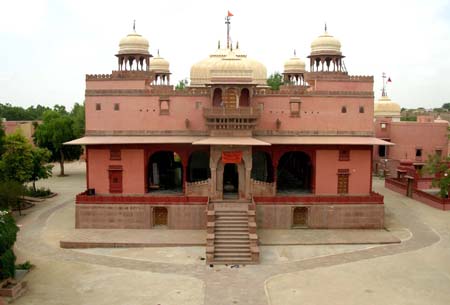
Bikaner, situated in the northern part of Rajasthan, was founded in 1488 by a descendant of the founder of Jodhpur named Rao Bhikaji. Like Jaisalmer, this town was an important city on the great caravan trade route during the medieval period. The city is surrounded by high fortifications comprising a seven-kilometre long wall which encircles the old city and has five entrances—all constructed in the 18th century. The city of Bikaner has seen several ups and downs in its eventful history. Bikaner Its proximity to Delhi made it bear the brunt of Mughal invasions time and again.
Legend has it that before embarking on his campaign, Rao Bhikaji sought the blessings of mystic Goddess Karni at Deshnoke. Since then the Karni Mata temple in Deshnoke continued to be patronized by the ruling family. Today hundreds of pilgrims flock the temple everyday to invoke the blessings of the Goddess, who is revered as an incarnation of Goddess Durga. Bikaner is also called the camel country, being renowned for the best riding camels in the world. It is also the birthplace of the world famous Bikaneri bhujia and namkeen (a salted snack made of lentils). Being a desertscape, the summers are very hot in Bikaner. The best time to visit this place is in winters when the weather remains cool and tolerable.
Sightseeing
Bikaner offers several attractions to the tourists besides, of course, the exotic camel safaris. You can visit the majestic forts or go to the Mata Karni temple where rats are considered sacred and worshipped. The camel festival held in the month of January is also an event worth witnessing. Some of the major attractions around the city are Junagarh Fort, Lalgarh Palace, Camel Breeding Farm, Gajner Palace, Deshnoke Temple and Ganga Golden Jubilee Museum.
Excursions
The excursions around Bikaner, besides giving a glimpse into the region’s culture and history, also provide an insight into the rich flora and fauna. The Gajner Wildlife Sanctuary (32 km from Bikaner) is home to a number of wild species including the nilgai, wild boar, chinkara and flocks of imperial sand grouse that migrate here every winter. Eight kilometres east of Bikaner lies Devi Kund where you can see some ornamented cenotaphs or chhatris.
Excursions for Bikaner
Junagarh Fort
The Junagarh Fort, built by Rai Singh between 1588 and 1593, has a 986-metre-long wall with 37 bastions, a moat and two entrances. Situated at a height of above seven hundred feet above sea level, it towers over the city and can be seen from a distance. The fort and its palaces are profusely decorated with magnificent stone carvings. The major buildings within the fort include the Anup Mahal, Diwan-e-Khas, Hawa Mahal, Badal Mahal, Chandra Mahal, Phool Mahal, Rang Mahal, Dungar Mahal, and Ganga Mahal. The Chandra Mahal has remarkable frescoes. Beautiful mirror work adorns the walls of Phool Mahal while golden pen work decorates the Anup Mahal.
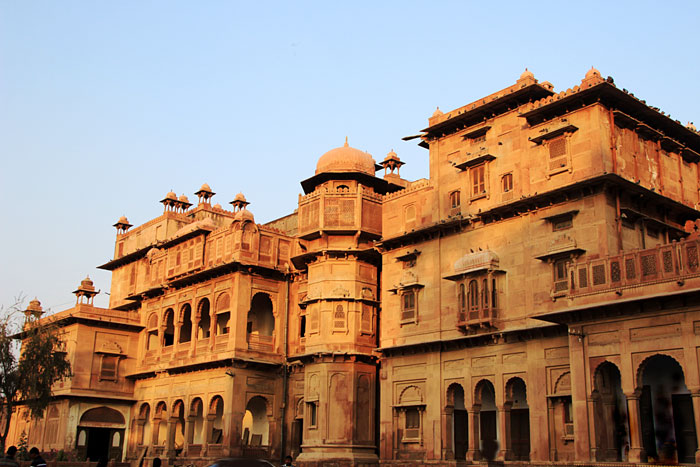
Lalgarh Palace

Built by Maharaja Ganga Singh in memory of his father, the Lalgarh Palace is situated 3 km north of Bikaner city. Designed by Sir Swinton Jacob, the palace is quite imposing with overhanging balconies and delicate latticework. Peacocks and blooming bougainvillea in the garden welcome the visitor to the palace. To promote tourism, the Rajasthan Tourism Development Corporation has converted a portion of this palace into a hotel.
Camel Research & Breeding Farm
Eight kilometres from Bikaner, the government-managed Camel Research and Breeding Farm is only one of its kinds in Asia. The farm carries out breeding and training of camels.

Gajner Palace
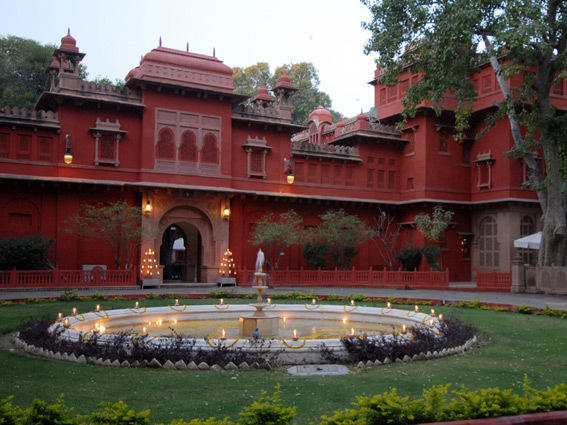
The place located on the bank of the lake was the summer resort of the former kings. Today it has been converted into a hotel.
Deshnoke Temple
Thirty kilometres south of Bikaner is the village of Deshnoke, where the famous Mata Karni Temple is situated. The 600-year-old temple is dedicated to Karni Mata, an incarnation of Goddess Durga. The temple has huge intricately carved silver gates donated by Maharaja Ganga Singh. The temple plays host to thousands of rats that form the major attraction here. The rats are considered sacred and worshipped accordingly. You have to be very careful while entering the inner sanctum, because it is believed that if you accidentally step on a rat, a gold replica has to be made to compensate for the lost life.
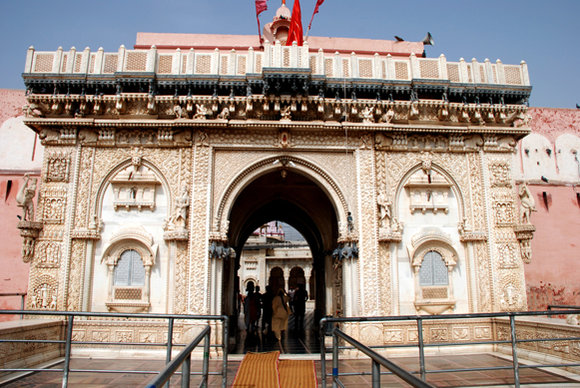
Ganga Golden Jubilee Museum
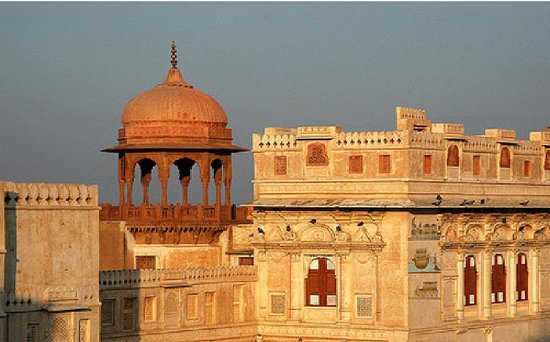
One of the best museums in Rajasthan, the Ganga Golden Jubilee Museum has one of the richest collections of terracotta ware, weapons, miniature paintings of Bikaner school and coins dating back to Harappan civilization and Gupta and Kushan era.
Shri Sadul Museum
To preserve the glory of the yesteryears of Rajasthan in general and Bikaner in particular, a part of the Lalgarh Palace has been converted into a museum. Known as the Sadul Museum, it covers the entire first floor of the palace. Some of the well-preserved old photographs and trophies of wildlife collected by the royalty have been housed here.
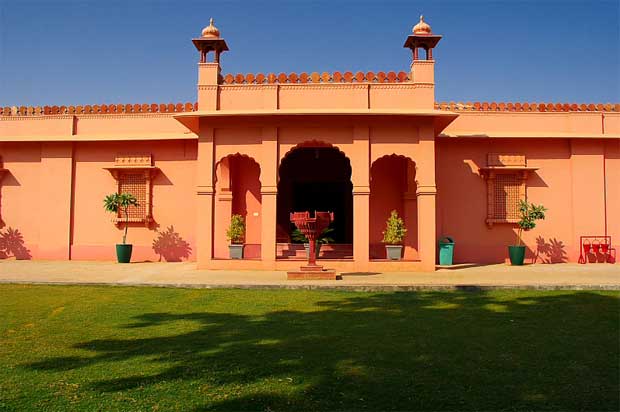
Fort Museum

The Ganga Mahal was Maharaja Ganga Singh/’s contribution to Junagarh Fort in the early 20th century. This pink sandstone hall, having walls carved with delicate tracery and scrollwork, today houses part of the fort museum. From jade-handled daggers to ivory-inlaid muskets, an exotic array of antique Rajput weaponry is on display here.
Devi Kund
Eight kilometres east of Bikaner lies Devi Kund, the site of a royal crematorium with several ornamented cenotaphs or chhatris built in the memory of the Bika dynasty rulers. The white marble chhatri of Maharaja Surat Singh is very imposing. Gajner Wildlife Sanctuary Just 32 kilometres from Bikaner, the Gajner Wildlife Sanctuary is home to a variety of wild animals. The adjoining lake that reflects the charming pink sandstone palace and gardens contrasts so effectively with the surrounding scrubland where black back, chital, sambhar, chinkara, nilgai, wild boar, rabbits, partridges, quail, and Indian bustard abound, that you wonder if it/’s real, or a desert mirage. From the paved terrace, you see jungle animals come down to the water for a drink. This lake attracts millions of migratory birds in winter. The Maharajah of Bikaner held house parties for shooting grouse, duck, and wild boar here.
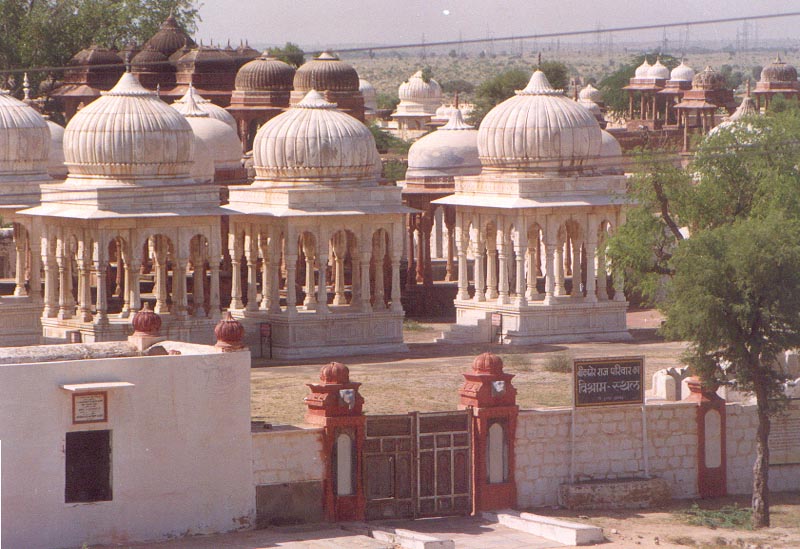
Fact File
 Area:165.75 sq. km
Area:165.75 sq. km
 Population:4,16,289
Population:4,16,289
 Altitude :237 metres above sea level
Altitude :237 metres above sea level
 Best Time to Visit:November–February
Best Time to Visit:November–February
 Languages:Rajasthani, Hindi, English
Languages:Rajasthani, Hindi, English
 STD Code: 0151
STD Code: 0151




